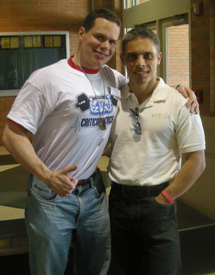Weight training is a lot more complex than what most non-athletes could ever imagine. Any guy can walk into a gym, pick up a dumbbell or a barbell and start lifting but chances are, he's not going to get the results he wants and even more likely-he's going to injure himself and not be able to train at all. Weight training is a combination of art, science, skill and self-knowledge. What is important is that you lift a weight that challenges your muscles-don't worry about what other guys are lifting-and that you focus on proper form. And an important part of proper form is the speed or tempo at which you perform your reps.
Lots of guys lift weights but not many of them do it right. That's a big part of the reason that you see almost as many out of shape guys inside the gym as you do outside of the gym. Just picking up a weight without giving any thought to technique, form and the lift speed can hamper your results more than you think. Knowing the proper tempo for the exercise you're doing and what you want to achieve from it can not only boost your gains, but prevent injuries too.
Before starting, you need to get this basic fundamental rule down: any lifting movement-whether it's fast or slow-must be done properly. Movements always need to be controlled, using an appropriate weight and the proper form. Movements should never be jerky or uncontrolled-that's how serious injuries occur. It's also important to note that it isn't a "fast" versus "slow" situation where one is better than the other. Both are great-which one you use depends on what you want to achieve.
Lifting the weight is the concentric part of the rep-aka the "positive." Lowering the weight is the eccentric part of the rep-the "negative." The faster you lift on the positive, the lower the muscle tension. Faster, explosive lifts on the positive enable you to lift more weight-but, you also sacrifice size. Increases in strength-not size-stem from faster positives.
This is why you often see Olympic powerlifters who
are incredibly strong, but not all that big.
Increases in size stem from high tension lifts-slower, controlled reps. High muscle tension achieved through slower positive lifts, combined with progressive overload is what leads to gains in muscle size. Progressive overload means increasing the weight, upping the number of reps (up to a max of about 12) or decreasing the rest time between sets. It's important to note that going really slow isn't going to result in exponential muscle growth though. The trick is to find the right tempo for your particular goals.
For example, if your goal is to increase muscle size…
a good rule of thumb is 2-3 seconds for the concentric contraction (lift) and 2-4 seconds for the eccentric contraction (lowering the weight). For a lot of exercises, it's generally a good idea to lower the weight a bit slower than the lift. The concentric contraction is where your muscles are doing all the work. The eccentric contraction is the part where your muscles face resistance. The resistance phase is important because it increases the flow of blood to the muscles. And more blood flow means more nutrients are getting to the muscles, which helps them get bigger and stronger.
Pauses also have an impact on the tempo of the workout.
For each exercise that you perform there can be two pauses: one after the concentric contraction and another after the eccentric contraction. When you're doing some exercises such as seated leg extensions, calf raises, bicep curls and others, you can benefit from a 1-2 second "pause and squeeze" to provide an extra bit of tension and help pump up your gains. The pause after the eccentric contraction is generally the "rest period" between contractions so that's usually kept to a minimum-like zero in most cases.
You'll often see tempos represented by a series of 3 or 4 numbers. In the 3-point expression, the first point is the eccentric contraction, the second point is the pause and the third point is the concentric contraction. In a 4-point expression, the last number is the resting pause.
If you haven't been giving your rep speed much thought, you can see why you should. Putting this planning effort into your routine can definitely lead to better results.
More Information About Muscle Building Click Here
Source 4 Foods Never To Eat

No comments:
Post a Comment